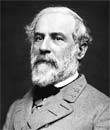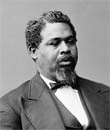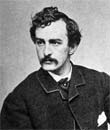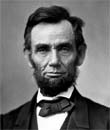
Day-by-Day Timeline of Events
February 21, 1861
President-elect Abraham Lincoln makes a stop in Philadelphia, Pennsylvania. He is made aware of an assassination plot against his life. In response a special train journey is arranged for him to Washington, D.C.
February 22, 1861
Abraham Lincoln, the President-elect of the United States, arrives safely in Washington, D.C.
February 23, 1861
Abraham Lincoln, President-elect of the United States, has his inaugural photograph taken at Matthew Brady's studio.
March 4, 1861
Abraham Lincoln is officially inaugurated as the next President of the United States, succeeding James Buchanan.
April 6, 1861
President Lincoln notifies the government of South Carolina that general supplies will be sent to Fort Sumter at Charleston Harbor - he gives his assurances that any strengthening of the position will only be made if the Fort is in danger of attack.
April 15, 1861
President Lincoln calls for a special session of Congress to discuss the growing rebellion in the south.
April 15, 1861
President Lincoln pushes for 75,000 soldiers who will each serve three-month tenures.
April 16, 1861
With the stroke of a pen, President Lincoln abolishes the practice of slavery in Washington, D.C.
April 16, 1861
President Lincoln calls on all states in the Union to cease doing business with those southern states that have moved to secede.
April 18, 1861

April 19, 1861
President Lincoln calls on all southern ports to be blockaded, the territories in question being the lower East Coast all the way to the Gulf of Mexico.
April 20, 1861
To avoid further clashes with troops, Baltimore formally asks President Lincoln to refrain from having military forces pass through the city.
April 27, 1861
President Lincoln adds east coast ports in Virginia and North Carolina to the existing naval blockade action of the South.
May 3, 1861
President Lincoln asks Congress for additional troops for three-year terms - hoping to bolster the ranks of the Army and Navy services. Some 42,000 volunteer forces are required.
July 2, 1861
President Lincoln suspends "writ of habeas corpus" in unique circumstances - the writ allowing a person the right to report an unlawful detention or imprisonment before a court.
July 4, 1861
President Lincoln, in a special session of Congress, asks for 500,000 men for the Union war effort. Current Union strength numbers 260,000 men with 165,000 of these being volunteers.
July 22, 1861
General George McClellan is handed control of the Division of the Potomac near Washington, D.C. by President Lincoln.
September 2, 1861
The emancipation of Missouri slaves by Union General John C. Fremont is put down by President Lincoln. He is then reassigned.
October 21, 1861
U.S. Army Colonel Edward Baker, a longtime and close friend of President Lincoln, is killed at Ball's Bluff, Virginia. He becomes the only sitting senator to be killed in action during the war.
November 1, 1861
General McClellan is named General-in-Chief of all United States military forces by President Abraham Lincoln.
December 2, 1861
In the next meeting of the United States Congress, President Lincoln calls for a new railroad to be constructed to help in the Union war effort.
December 20, 1861
Viewing Lincoln as too much a pacifist, the "Radical Republicans" of the United States Congress arrange the Joint Committee on the Conduct of the War.
December 21, 1861
The Navy Medal of Honor is signed into law by President Lincoln (Public Resolution 82).
January 27, 1862
In an effort to stir General McClellan to action, President Lincoln announces a deadline of February 22 for an all-out advance of Union forces against confederate positions.
February 20, 1862
Willie Lincoln, son of the President of the United States, succumbs to fever at the age of eleven.
February 22, 1862
Andrew Johnson is announced as military governor by President Lincoln over Union-held territories of Tennessee.
March 6, 1862
To assuage Union border states, President Lincoln pushes for compensation to slave owners who end up losing their slaves.
March 11, 1862
Having grown tired of General McClellan's inaction to this point in the war, President Lincoln moves to take the General's title of General-in-Chief away. McClellan continues to lead as commander of the Army of the Potomac.
April 10, 1862
Once again President Abraham Lincoln is forced to plead for General McClellan to move to action in Virginia - comparing the current offensive with what was witnessed at Manassas some time earlier.
May 13, 1862

May 20, 1862
The Homestead Act is signed into law by President Lincoln. This is arranged to encourage western migration for settlers and offered to those who have not gone against the Union.
June 6, 1862
The Army of Virginia (formerly the Army of the Potomac) is now handed to General John Pope per President Lincoln's order.
July 11, 1862
General Henry W. Halleck is appointed General-in-Chief over Washington, D.C. by President Lincoln.
August 5, 1862
Confederate Captain Alexander Todd is killed in fighting near Baton Rouge, Louisiana. Todd is the brother-in-law of sitting President Abraham Lincoln. He is also the victim of friendly-fire.
September 2, 1862
Union General John Pope is relieved of command of the Army of Virginia by order of President Lincoln.
September 2, 1862
General George McClellan is appointed by President Lincoln to succeed outgoing General Pope as leader of the Army of Virginia.
September 22, 1862
President Lincoln's Emancipation Proclamation is set to take effect on January 1st, 1863. The proclamation covers only those slaves in Confederate-governed states but excludes those border states supporting the Union.
November 5, 1862
General Ambrose Burnside replaces General George McClellan as commander of the Army of the Potomac per President Lincoln's request.
December 1, 1862
Abraham Lincoln addresses the U.S. Congress. In his speech, he declares openness to allowing freed slaves the option to resettle in other countries.
January 1, 1863
Lincoln's Emancipation Proclamation goes into effect. The proclamation does not cover those slaves residing in states within the Union itself.
January 4, 1863
President Lincoln is at odds with General Grant on the topic of expelling Jewish merchants operating within Grant's military district. He calls on Grant to repeal the earlier expulsion order.
January 25, 1863
General Hooker is placed in charge of the Army of the Potomac - succeeding General Burnside. The assignment is handed down by President Lincoln himself.
May 5, 1863
With vocal and public opposition to to Lincoln's war, Congressman Clement Vallandigham (Ohio) is arrested.
May 19, 1863
Vocal war critic (and now disgraced U.S. Congressman) Clement Vallandigham is banished to the South by President Lincoln.
June 27, 1863
General Joseph Hooker of the Union Army tenders his resignation from the Army of the Potomac due to a dispute with Army HQ on the status of the defense at Harpers Ferry. The resignation is accepted by President Lincoln.
July 30, 1863
The Order of Retaliation is handed down by President Lincoln. The measure calls for the execution of one Confederate soldier for every one Union soldier killed in violation of the rules of war.
October 3, 1863
"Thanksgiving Day" is formally announced by the United States government. It will be celebrated annually from then on.
October 16, 1863
Command of the armies of the West are handed to General Ulysses S. Grant by order of President Lincoln.
November 19, 1863
The Gettysburg Address is delivered by President Lincoln on the battlefield itself. It becomes one of the most revered and iconic speeches in American history despite its rather short length. The speech serves to dedicate the Soldier's National Cemetery in Gettysburg proper.
December 7, 1863
President Lincoln calls on church-goers to thank God for the Union victory at Chattanooga.
December 7, 1863
The Proclamation of Amenesty and Reconstruction is issued by President Lincoln. The measure is part of Lincoln's plan for reunification and provides pardons to Confederates willing to take an oath of loyalty to the United States of America.
December 8, 1863
In an address to Congress, President Lincoln reveals that around 100,000 former slaves have joined the Union ranks in the fight against the South.
March 12, 1864
General Henry Halleck is replaced with General Grant by President Lincoln. Grant will now head the Union Army as its General-in-Chief.
April 18, 1864
In a speech given at the Sanitary Fair at Baltimore, President Lincoln cautions against retaliation.
May 31, 1864
The "Radical Democracy Party", a divisional group of the Republican Party, nominates former Union General John Fremont to run against incumbent Abraham Lincoln in the 1864 election.
June 7, 1864
Abraham Lincoln and Andrew Johnson are elected by the Republican Party to run for a second term in office. The party convention is held in Baltimore, Maryland with the war still ongoing.
June 28, 1864
The Fugitive Slave Act of 1850 is repealed. The measure is officially signed by President Lincoln. The law called for recaptured runaway slaves in Northern territories to be returned to their masters in the South.
July 2, 1864
The Wade-Davis Bill of 1864, covering a proposal for reconstruction of the South following a conclusion to the war, is passed by both houses of Congress. However, much to the dismay of Radial Republicans, Lincoln does not sign the bill. Instead it is vetoed as Lincoln looks for a less severe plan. Authors of the Wade-Davis Bill are Senator Benjamin Wade (Ohio) and Representative Henry Winter Davis (Maryland).
July 4, 1864
A bill proposing that the U.S. Congress be placed in charge of the reconstruction of the South following the war is vetoed by Presidetn Lincoln.
July 4, 1864
A new provision signed into law by President Lincoln now guarantees a $100 yearly bonus to Union troops.
July 11, 1864
Fort Stevens in Washington, D.C. is fired upon by elements of Confederate General General Early (the Battle of Fort Stevens). This occurs during a visit by President Lincoln.
Aigust 29, 1864
Union General George McClellan is nominated by the Democratic Party in Chicago, Illinois. He will square-off in the Presidential Election of 1864 against incumbent Abraham Lincoln.
November 8, 1864
Incumbent President Abraham Lincoln (a Republican) wins a second term in the unprecedented election held during the American Civil War. He handily defeats Union General George McClellan (a Democrat) 212 to 21 Electoral Votes. Though Louisiana and Tennessee are firmly under Union control, their electoral votes are not counted officially. Lincoln's running mate is Andrew Johnson. Lincoln carries Illinois but does not win Kentucky.
November 8, 1864
Despite the ongoing war, the President Election is held on this date. Incumbent Abraham Lincoln decisively wins over challenger General George McClellan. Andrew John remains as Vice President.
December 6, 1864
Salmon Chase, the former Secretary of the Treasury, is appointed to the Supreme Court by President Lincoln.
December 26, 1864
President Lincoln, by letter, personally thanks General William Sherman for his successful campaign - his 'March to the Sea' - which began on November 15th that finally delivered Savannah, Georgia in time for Christmas.
January 16, 1865
Confederate President Jefferson Davis discusses peace with Francis Blair, Sr, advisor to President Lincoln. The talks are held in secret.
February 3, 1865
Alexander Stephens, representing the Confederacy as its Vice President, offers a peace to President Lincoln during a meeting taking place at Hampton Roads in Virginia. The peace overture is rejected by the President.
February 5, 1865
In an effort to help end the bloodshed of the Civil War, President Lincoln offers monetary compensation to the South pending their acceptance of the 13th Amendment and a cessation of fighting. However, Lincoln's own people do not support the plan so it is dropped.
March 2, 1865
Confederate General Robert E. Lee offers peace negotiations to President Lincoln. The overture is rejected.
March 4, 1865
The second inauguration of President Lincoln is had on this date. In the audience is future assassin, actor John Wilkes Booth.
March 17, 1865

March 24, 1865
President Lincoln begins a three-week visit to General Grant at his headquarters in City Point, Virginia. Among those in attendance is General Sherman.
March 28, 1865
In a meeting with top officers, President Lincoln pushes for surrender of the Confederacy under softer terms.
April 5, 1865
President Lincoln tours the former Confederate capital of Richmond following its capture by Union forces.
April 14, 1865
On this date (Good Friday), President Lincoln is shot by actor John Wilkes Booth during the play "Our American Cousin" at the Ford's Theater in Washington, D.C. Other targets of the attack are Andrew Johnson and William H. Seward.
April 14, 1865
In the same attack that would claim the life of President Lincoln, Secretary of State William Seward is stabbed but survives.
April 15, 1865
President Lincoln dies from his wound at 7:22AM at the Petersen house across the street from Ford's Theater.
April 19, 1865
Lincoln's funeral procession takes place down Pennsylvania Avenue in Washington, D.C.
April 19, 1865
Confederate President Davis, now in Charlotte (North Carolina) is informed of President Lincoln's assassination and death.
April 21, 1865
The Lincoln Funeral Train departs Washington, D.C. en route to Springfield, Illinois.
May 4, 1865
Slain President Abraham Lincoln is laid to rest at Oak Ridge Cemetery (Springfield, Illinois).
May 10, 1865
En route to kill President Lincoln, Confederate Captain William Quantrill is mortally wounded by elements of the Union Army.
July 7, 1865
Mary Surratt, George Atzerodt, Lewis Powell and David Herold are executed for their part in the plot to assassinate President Lincoln. The executions by hanging take place at Fort McNair in Washington, D.C.


